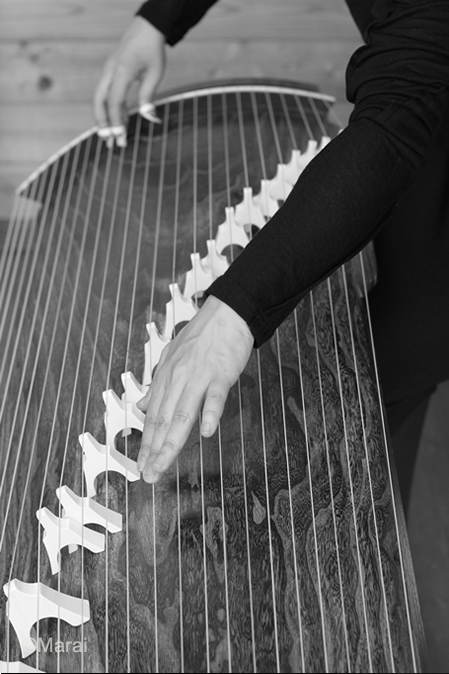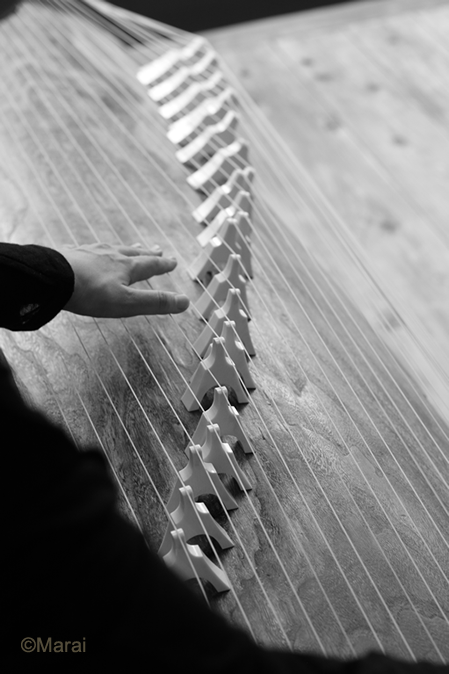



My first encounter with koto dates back to my kindergarten days.
When I went to visit my friend Aya at her house, I saw a sliding door that I hadn't noticed before. Even as a child I felt a tinge of guilt as I opened the door to see what was on the other side. It was a dusky tatami room and nobody was in it.
But as I looked harder into the darkness, I saw a long piece of wood lying on the floor. It had many strings stretched across it. I felt a cold air surrounding the wood, like it was not meant to be touched. I looked around the room, then gently touched one of the strings--and a sound came out of it. It felt as if a soft color filled the dusky room.
Delighted, I touched the string next to it, and now a different sound came out of it. I touched another string, then another . . . and it felt like a layer of sound came pouring onto me.
And the sounds made up a familiar song. It was "Sakura sakura."
In this air, I felt like my body was filling up with something I had never felt before, and kept making those sounds over and over again. But when I stopped my hand, the room went back to being an empty, dusky room. I got scared all of a sudden and left the room.
I kept wishing to touch the wood again, but I didn't have a chance to do so for a long time. I cannot forget the joy I felt when I finally had the chance to play the koto ten years later.
Ever since then, my feelings about koto have not changed even slightly.
The sound of koto is what I yearn for, and the air it creates is, for me, magic.

 Born in Miyagi Prefecture.
Studied Ikuta-ryu sokyoku and jiuta sangen with Masami Sawamura and Shokei Sawamura since 1988. Has studied 25-string koto with Mizuyo Komiya since 2005.
Works with both classic and contemporary music primarily on 25-string koto.
Has given concerts annually since 2007. The concert in 2010 was held at Opera City Omigakudo Hall; the 2011 and 2012 concerts were at Ongaku-no-tomo Hall. Member of the Matsunomi-kai.
Born in Miyagi Prefecture.
Studied Ikuta-ryu sokyoku and jiuta sangen with Masami Sawamura and Shokei Sawamura since 1988. Has studied 25-string koto with Mizuyo Komiya since 2005.
Works with both classic and contemporary music primarily on 25-string koto.
Has given concerts annually since 2007. The concert in 2010 was held at Opera City Omigakudo Hall; the 2011 and 2012 concerts were at Ongaku-no-tomo Hall. Member of the Matsunomi-kai.

Koto is a traditional Japanese stringed instrument. Its history dates back to the Nara period (710-784 AD). The instrument consists of thirteen strings strung along a hollow body made of paulownia wood. The pitch for each string is adjusted by placing a movable bridge (kotoji) underneath the string. The player plucks the strings with three finger picks on the right hand. The appearance of koto is considered to resemble a ryu (dragon), and each part of the instrument is given dragon-related names such as ryukaku (dragonhorn) and ryubi (dragontail). Koto is often confused with the instrument kin, which is also a Japanese stringed instrument. However, kin is a different instrument from koto, as the former is a seven-stringed instrument whose pitch is adjusted by pressing on the strings with the finger rather than by placing bridges underneath.
As Japan went through a wave of Westernization during the Meiji period (1868-1912), koto also came under the influence of Western music. In the early Showa period (1926-1989), Michio Miyagi, who felt the need for lower pitches for the instrument, created a seventeen-stringed bass koto. The koto music that incorporated bass notes brought fresh innovations to the Japanese sound.
Mid-Showa period brought a new wave of contemporary koto music. As a new generation of composers trained in Western musical traditions, such as Akira Ifukube, began to write music for Japanese instruments, there arose a demand for a greater range of sound from koto. Adjusting the pitch solely through the placement of bridges, each string on koto can create only a single pitch. Although the player can create a wider range of pitches by pressing or loosening the bridges, it is difficult to play many chords or to respond to key changes. In light of these challenges, Keiko Nosaka (currently Soju Nosaka) designed the twenty-stringed koto. She then added another string, then another, to the instrument, until establishing the twenty-five-stringed koto played today. Because it uses strings of about ten different thickness, the twenty-five-stringed koto not only has a wide range of pitch but also a variety of tonalities as well as dynamics, and it has come to have a great presence as an instrument that plays diverse roles in music-making.



